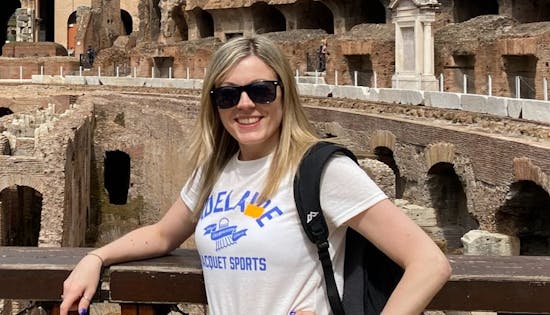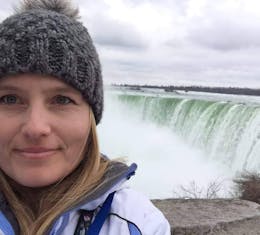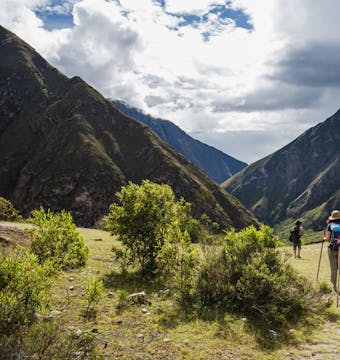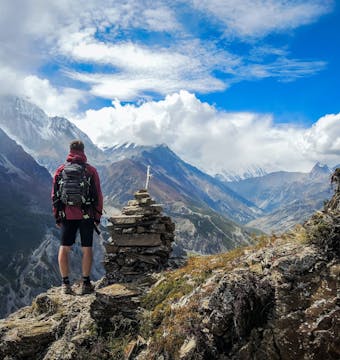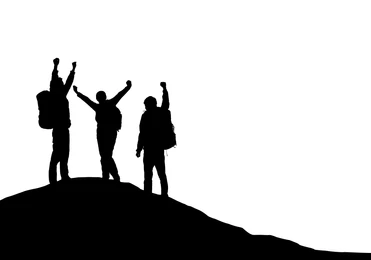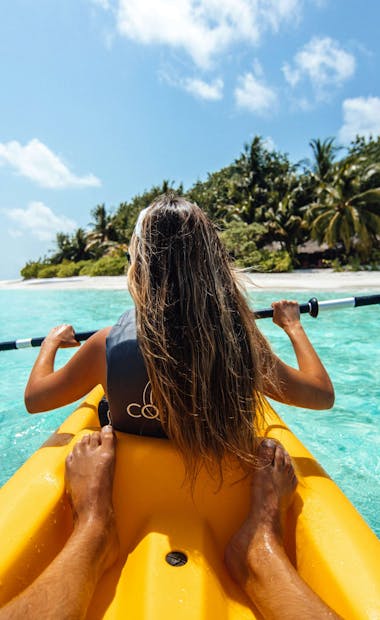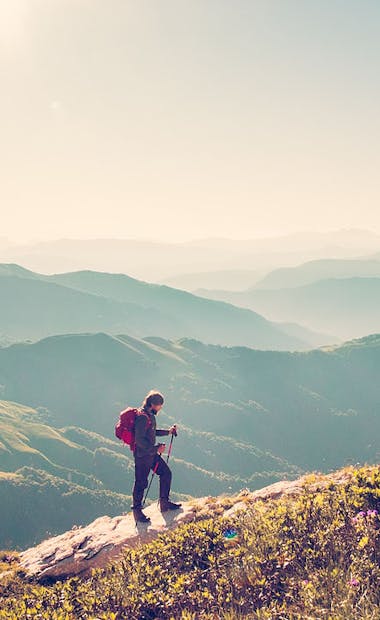
Trekking
From The Inca Trail to Everest Base Camp, explore the world through trekking
Popular tours
- Save6%
 View Tour
View TourClassic Inca Trail & Machu Picchu - 4 Days
- Cusco to Cusco
- Age group: 3 - 99
- Max group size: 16
Was:£608From£574 - Save11%
 View Tour
View TourClimb Kilimanjaro - Machame Route - 7 Days
- Moshi to Moshi
- Age group: 18 - 99
- Max group size: 20
Was:£1,617From£1,440 - Save25%
 View Tour
View TourTorres del Paine - The W Trek - 6 Days
- Puerto Natales to Puerto Natales
- Age group: 12 - 100
- Max group size: 16
Was:£2,199From£1,641 - Save10%
 View Tour
View TourTrekking Mont Blanc - 10 Days
- Chamonix-Mont-Blanc to Chamonix-Mont-Blanc
- Age group: 12 - 100
- Max group size: 12
Was:£1,799From£1,611 - Save12%
 View Tour
View TourWalk the Camino de Santiago - 8 Days
- Sarria to Santiago de Compostela
- Age group: 12 - 100
- Max group size: 16
Was:£1,129From£991 - Save20%
 View Tour
View TourThe Lares Trek - 7 Days
- Cusco to Cusco
- Age group: 12 - 100
- Max group size: 16
Was:£959From£763
Trekking Holidays
Step into a world of awe-inspiring landscapes, invigorating adventures, and intimate encounters with nature through small group guided trekking and walking holidays. If you crave the thrill of exploring on foot, immersing yourself in pristine wilderness, and discovering hidden gems off the beaten path, then these carefully crafted journeys are tailor-made for the adventurous souls seeking an extraordinary travel experience.
Imagine embarking on a journey that combines the freedom of walking with the expertise of experienced guides who unveil the secrets of each trail. With a small group of like-minded explorers, you'll venture into breathtaking terrain, traversing rugged mountain trails, winding through ancient forests, and crossing pristine valleys. These guided treks and walking holidays are a captivating blend of physical exertion, natural beauty, and cultural discovery.
As you lace up your boots and set off on your adventure, you'll discover that there's something profoundly transformative about traveling at the pace of your own footsteps. Each day brings new challenges and rewards, as you push your limits, build resilience, and immerse yourself in the awe-inspiring wonders of nature. Whether ascending to lofty mountain passes, tracing the contours of a coastal cliff path, or meandering through quaint villages, every step offers a sense of accomplishment and a deeper connection to the world around you.
But it's not just about the physical challenge. Small group guided trekking and walking holidays provide an opportunity to delve into the heart and soul of the destinations you explore. Expert guides, often local to the region, share their in-depth knowledge, weaving captivating stories about the land's history, culture, and natural wonders. You'll witness the unfolding beauty of pristine landscapes, encounter wildlife in their natural habitats, and engage with local communities, gaining a deeper understanding of the regions you traverse.
One of the greatest joys of small group guided trekking and walking holidays lies in the camaraderie and shared experiences with fellow travelers. As you tackle challenging terrains together, exchange laughter, and encourage one another, bonds are forged that transcend borders and cultures. Lifelong friendships are formed as you celebrate triumphs, share breathtaking vistas, and relish in the shared sense of adventure.
These immersive journeys are designed to accommodate various fitness levels and preferences, with itineraries ranging from leisurely walks to more demanding treks. Whether you're a seasoned hiker or a novice explorer, there's a guided trekking or walking holiday that suits your abilities and desires. Your tour operator will ensure your safety and comfort, providing well-planned routes, support vehicles, knowledgeable guides, and handpicked accommodations that offer respite after a day on the trail.
So, if you yearn to escape the ordinary and embrace the extraordinary, let small group guided trekking and walking holidays transport you to some of the world's most captivating landscapes. Lace up your boots, take that first exhilarating step, and allow the trail to lead you on a transformative journey where breathtaking scenery, enriching encounters, and the spirit of adventure converge. The world awaits your exploration, one trail at a time.
Where To Trek?
There are numerous popular trekking holidays and routes around the world that attract adventure enthusiasts from all walks of life. The popularity of these treks is often attributed to their stunning natural beauty, unique cultural experiences, and the sense of achievement they offer. Here are some of the most renowned and sought-after trekking holidays and routes:
Everest Base Camp Trek, Nepal: Undoubtedly one of the most iconic treks in the world, the Everest Base Camp Trek takes you through the legendary Khumbu region of Nepal. This challenging trek offers breathtaking views of the Himalayas, including Mount Everest, as you navigate rugged trails, picturesque Sherpa villages, and high-altitude passes.
Inca Trail, Peru: The Inca Trail is a legendary trek that leads to the mesmerizing ancient ruins of Machu Picchu. This four-day trek takes you through diverse ecosystems, including cloud forests and high mountain passes, while offering glimpses of Inca ruins and breathtaking vistas along the way.
Kilimanjaro, Tanzania: Mount Kilimanjaro, the highest peak in Africa, attracts adventure seekers from around the globe. Climbing Kilimanjaro is an extraordinary experience that involves trekking through various ecological zones, from lush rainforests to barren alpine deserts, before reaching the summit at Uhuru Peak.
Tour du Mont Blanc, France, Italy, and Switzerland: The Tour du Mont Blanc is a classic trek that encircles the majestic Mont Blanc massif, spanning through three countries. This long-distance trek showcases stunning alpine scenery, charming mountain villages, and the opportunity to savor the flavors of French, Italian, and Swiss cuisine.
Annapurna Circuit, Nepal: The Annapurna Circuit is a renowned trek that takes you through the Annapurna region of Nepal. This challenging route offers a diverse range of landscapes, including terraced fields, rhododendron forests, high mountain passes, and dramatic Himalayan vistas. It also provides opportunities to immerse in the local culture and interact with diverse ethnic communities.
Torres del Paine Circuit, Chile: Located in Chile's Patagonia region, the Torres del Paine Circuit is a trekking route that showcases awe-inspiring landscapes. Hikers are treated to towering granite peaks, turquoise lakes, glaciers, and unique flora and fauna as they navigate this remote and pristine wilderness.
West Highland Way, Scotland: The West Highland Way is Scotland's premier long-distance walking route, offering a stunning journey through the country's picturesque landscapes. This 96-mile trail takes you from the lowlands of Milngavie to the highlands of Fort William, passing through lochs, moors, and enchanting forests.
These are just a few examples of the most popular trekking holidays and routes. There are many other incredible treks around the world, each with its own unique appeal and challenges. When choosing a trek, consider factors such as difficulty level, altitude, climate, and the duration that suits your preferences and fitness level. It's also important to be well-prepared, follow safety guidelines, and travel with experienced guides or tour operators who specialize in trekking adventures.
Do I need a lot of experience for the trekking trips?
No, you do not necessarily need to be an experienced trekker to join a small group guided trip holiday. Many guided trekking trips cater to a range of experience levels, from beginners to seasoned hikers. The beauty of guided trips is that they often offer options and flexibility to accommodate different fitness levels and trekking abilities.
Tour operators typically provide detailed itineraries that outline the difficulty level, duration, and physical demands of the trek. This allows you to choose a trek that aligns with your fitness level and preferences. Some guided trips are designed for beginners or families with children, featuring shorter and less strenuous routes with ample support and rest days. Others may offer more challenging treks for experienced hikers looking for a physically demanding adventure.
Guided trips provide several benefits for less-experienced trekkers. Expert guides accompany the group, ensuring your safety, offering support and guidance, and sharing their knowledge about the trail, local culture, and environment. They are often trained in first aid and have extensive experience in leading treks, making them valuable resources throughout the journey.
Additionally, guided trips typically provide necessary equipment, arrange accommodations, and handle logistics such as permits and transportation, relieving you of the burden of organizing these aspects yourself. This allows you to focus on the experience and enjoyment of the trek without the added stress of planning and logistics.
While prior fitness and some level of physical preparedness are beneficial for any trek, it's not uncommon for individuals with varying fitness levels to participate in guided trips. However, it's always recommended to consult with the tour operator or trip organizer to ensure you choose a trek that suits your capabilities and to discuss any concerns or questions you may have.
Remember, joining a small group guided trip holiday is an excellent opportunity to challenge yourself, learn new skills, and immerse yourself in the natural beauty of the trekking destination. With the right mindset, proper preparation, and the support of experienced guides and fellow travelers, you can embark on a rewarding trekking adventure regardless of your previous experience.
How does the rooming work on tours?
Small group walking and trekking tours typically involve a set itinerary where you travel with a group of fellow travellers and a tour leader/guide. Accommodation arrangements vary depending on the specific tour you choose. Here are some common aspects of rooming arrangements on small group tours:
Shared Rooms: In order to promote camaraderie and facilitate interaction among group members, most tours arrange shared accommodation. This means you will be paired with another member of the same gender from the group to share a room. Roommates may sometimes change periodically throughout the tour.
Single Supplement: If you prefer to have your own room and privacy, you may have the option to pay a single supplement fee. This additional fee allows you to have your own room for the duration of the tour. However, please note that single supplements can vary in cost and availability.
Roommate Matching: Tour operators usually offer roommate matching services, where they try to pair you with a suitable roommate based on your preferences, such as age range. This can help ensure compatibility and a more enjoyable experience for all participants.
Rooming Preferences: When booking your small group tour, it's important to communicate your rooming preferences to the tour operator. If you have specific requirements or preferences, such as sharing with a friend or a specific roommate request, it's advisable to inform the tour operator during the booking process.
It's important to carefully read the tour details and inclusions provided by the tour operator to understand their specific rooming policies. If having your own room is a priority, make sure to inquire about the availability of single supplements and any associated costs before booking your tour.
Keep in mind that while sharing a room with a fellow traveller can be a great way to meet new people and build connections, having your own room provides more privacy and flexibility. Consider your preferences and the dynamics of the tour when deciding whether to opt for a shared room or pay for a single supplement.
Remember to communicate your needs and preferences clearly with the tour operator during the booking process to ensure a comfortable and enjoyable accommodation experience on your small group trek.
Will someone be transporting our luggage?
Yes, on most guided trekking holidays your luggage will be transported for you on a daily basis to your next stop. This allows you to focus on the trek itself without the burden of carrying your entire luggage throughout the journey.
Typically, on guided treks, a support team or porters will be responsible for transporting the main luggage from one accommodation point to another. This can include tents, sleeping bags, extra clothing, and any other gear not required during the day's trek. The porters or support team will ensure that your luggage is safely transferred and ready for you at the next overnight stop.
It's important to note that there are weight limitations for the luggage that can be transported by porters. The specific weight limit may vary depending on the trek. Therefore, it's advisable to check with the details or with our team about the luggage weight restrictions and any guidelines regarding the type of bags that can be used (e.g., duffel bags or backpacks).
During the trek, you will typically be required to carry a daypack with essential items such as water, snacks, extra layers, camera, sunscreen, and any personal items you may need throughout the day's hike. The daypack is usually smaller and more manageable, allowing you to hike comfortably while keeping necessary items within easy reach.
It's essential to communicate with us about the luggage arrangements and clarify any questions or concerns you may have. We can provide specific information about the luggage transport logistics for your particular trek, ensuring a smooth and enjoyable experience on the trail.
Is there any basic gear I need?
When embarking on a guided trekking holiday, it's important to have the appropriate gear to ensure your comfort, safety, and enjoyment throughout the journey. While specific gear requirements may vary depending on the destination and trek difficulty, here are some essential items to consider:
Hiking Boots: Invest in a sturdy pair of hiking boots that provide ankle support, good traction, and are comfortable for long walks. Ensure they are broken in before the trek to avoid blisters and discomfort.
Backpack: Choose a backpack of appropriate size to carry your essentials during the trek. Look for one with padded straps and a waist belt for added comfort. Consider a waterproof cover or liner to protect your belongings from rain.
Clothing: Layering is key for trekking. Pack moisture-wicking base layers, lightweight and breathable shirts, long pants, and a waterproof and windproof jacket. Carry extra warm layers for higher altitudes or colder conditions.
Headwear: Protect yourself from the sun with a wide-brimmed hat or a cap. Additionally, pack a beanie or a buff for colder climates or higher altitudes.
Gloves: Carry lightweight gloves for chilly weather or higher altitudes where temperatures may drop. Opt for waterproof gloves if you anticipate encountering rain or snow.
Socks: Invest in moisture-wicking, cushioned hiking socks to prevent blisters and keep your feet comfortable. Pack multiple pairs to rotate during the trek.
Trekking Poles: Trekking poles provide stability and reduce strain on your knees and joints during descents. They can be especially useful on steep or uneven terrain.
Sleeping Bag: If overnight stays in mountain huts or camping are part of the trek, bring a sleeping bag suitable for the expected temperatures. Check with your tour operator for specific recommendations.
Water Bottle and Water Purification: Carry a reusable water bottle to stay hydrated throughout the trek. Some destinations may require water purification methods, such as water filters or purification tablets, to ensure safe drinking water.
First Aid Kit: Pack a basic first aid kit with essentials such as bandages, antiseptic ointment, blister treatment, pain relievers, and any personal medications you may need. Your tour operator may provide a comprehensive first aid kit, but it's always good to have personal supplies.
Other Essentials: Don't forget essentials like sunscreen, insect repellent, sunglasses, a headlamp or flashlight, a whistle for emergencies, trekking maps or guidebooks, and a camera to capture your memories.
It's essential to check with your tour operator or trekking company for a detailed gear list specific to your trek. They can provide valuable insights on any additional gear or equipment required based on the destination, weather conditions, and the services they provide.
Remember to pack sensibly and keep your backpack as light as possible while including all the necessary items. Properly preparing and having the right gear will enhance your trekking experience and allow you to fully enjoy the breathtaking landscapes and adventures along the way.
Trekking at altitude
It’s hard to know how this will affect you - as it can have an impact on travellers regardless of age, prior experience at altitude or fitness level. It certainly takes a couple of days to get used to the altitude so definitely take the time to do so. Ask our team if you are unsure how to add this in to your trip, but most include this in the itinerary.
Most people will experience some symptoms of altitude but as long as you are well prepared, you will get aclimitise in a few days and have a great time. Make sure you drink lots of water, take your time, listen to your body and let your leader know if you are feeling unwell. All leaders trekking at altitude are full trained in recognising the symptoms of rare, but more serious conditions that can arise at altitude.
If you have any concerns or are worried about medical conditions you should speak to your GP before travelling. We strongly recommend against buying medications that are available over the counter in some destinations without previously speaking to your GP.
Can I opt out of any of the walking?
On most guided trekking holidays, you have the flexibility to opt out of specific walks or sections of the trek if needed. While trekking holidays are primarily designed for hiking and exploring on foot, tour operators understand that individual preferences and circumstances can vary.
If you feel the need to opt out of a particular walk due to fatigue, injury, or any other reason, it's essential to communicate your concerns to the tour guide or trek leader. They will be able to provide guidance and explore alternatives that suit your needs. In some cases, depending on the logistics and the availability of support vehicles or alternative transportation, arrangements can be made for you to skip a particular section and rejoin the group later.
It's important to remember that opting out of walks or sections of a trek may impact your overall experience and the itinerary. Some treks may have limited access points or alternate routes, and certain highlights or viewpoints may be missed if you choose to skip sections. Additionally, opting out of walks should be based on genuine concerns for your well-being or safety and not solely for convenience or preference.
When considering opting out of walks, it's advisable to have an open and honest conversation with the tour operator or trek leader. They can provide guidance on the specific conditions, difficulties, and alternatives available, ensuring that you make an informed decision that aligns with your needs and maintains the overall group dynamics.
Ultimately, guided trekking holidays are designed to provide an immersive and rewarding experience. While walking is a significant component of these trips, tour operators aim to accommodate the varying abilities and preferences of participants, within the limitations of the trek and its logistics.
Do we still walk in bad weather?
Guided trekking holidays prioritise the safety and well-being of participants. Therefore, the decision to walk in bad weather during a trek will depend on several factors, including the severity of the weather conditions, the terrain, and the expertise of the guides.
In general, trek leaders and guides closely monitor weather conditions and take appropriate measures to ensure the safety of the group. They are experienced in assessing weather patterns and understanding the potential risks associated with trekking in adverse conditions. In situations where the weather poses a significant safety risk, such as severe storms, landslides, or other hazardous conditions, trekking may be temporarily halted or alternative plans may be made.
However, it's important to note that trekking holidays often involve hiking in varied and sometimes challenging environments, where weather conditions can change rapidly. Mild rain, wind, or light snowfall may still be deemed acceptable for continuing the trek, especially if the terrain and trail conditions are manageable. In such cases, the guides may modify the itinerary, adjust the pace, or take necessary precautions to ensure the safety and comfort of the group.
Your safety and the safety of the group are paramount. It's crucial to follow the instructions and advice of the trek leader or guide regarding trekking in inclement weather. They will have the knowledge and experience to make informed decisions based on the specific circumstances and group dynamics.
Before embarking on a guided trekking holiday, it's a good idea to familiarize yourself with the expected weather conditions of the destination and season. This will help you prepare appropriate clothing and gear for a range of weather scenarios. Being mentally prepared for potential weather challenges can also enhance your overall experience on the trek.
Remember that adverse weather conditions can add an element of unpredictability to the trek, but they can also provide unique experiences and perspectives. The key is to prioritize safety and trust the expertise of your guides and tour operators in making informed decisions regarding trekking in bad weather.
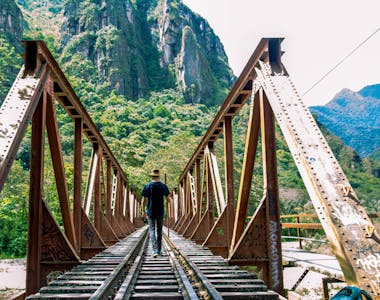
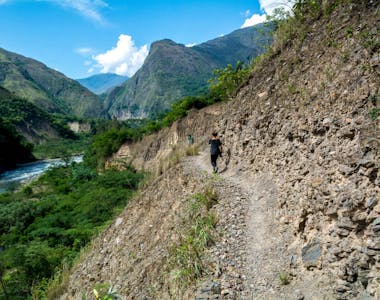
Trekking Highlights
Book With Confidence
Monthly Payments
Spread the costs with no interest or additional fees
Best Price Guarantee
We won't be beaten on price. If you find this adventure at a lower price please get in touch!
Reserve now & pay later
Reserve your adventure today and pay later, free of charge
ATOL protected
Book with confidence
Hold your space today, for free
or book your trip with a deposit and then pay the rest in instalments.
Reserve your flights with us
Add flights to your booking and we'll take care of the rest. You'll get 24/7 support from our team & ATOL protection.
Speak to our experts
Call or email our expert team to find out more and help with ideas and planning.
